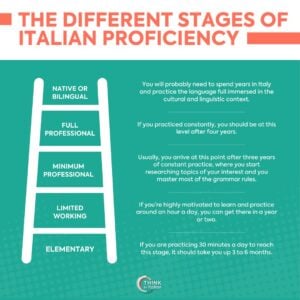When to use Essere in Italian
“Essere, o non essere, questo è il dilemma.”
Do you recognize that phrase?
It’s the translation of what Hamlet said: “To be or not to be, that is the question”.
Before we go into more detail, it’s essential that you know when we use the verb essere in Italian:
- To describe someone/something
- To talk about someone’s origin/nationality
- To indicate possession
Let’s get started!
Why learn the auxiliary verb Essere
Learning the essere conjugated form is essential if you want to learn Italian because it is the most common verb (together with avere).
Essere is an auxiliary verb, meaning it can be used to form other verb tenses.
Because Essere is an irregular verb, you’ll have to memorize all of its forms.
But don’t worry—once you understand how compound tenses are formed, you’ll be halfway there.
Let’s look at the irregular conjugations of the verb essere and how it’s used in everyday Italian phrases.
The essere’s finite moods
In Italian, there are four moods: indicative, subjunctive, conditional, and imperative.
Conjugation in the Indicative Mood
The indicative mood is composed of eight tenses: four simple tenses, and four compound tenses. It is used to express certainty that an action happened or that it will happen.
Essere conjugation: the present tense
As mentioned before Essere follows an irregular conjugation, – this means that you can’t apply the rules of regular verbs when conjugating essere, but you need to learn it by heart.
Let’s first see how we conjugate the irregular verb essere in the present tense:
| Io sono | I am |
| Tu sei | You are |
| Lui/lei è | He, she is |
| Noi siamo | We are |
| Voi siete | You are |
| Loro sono | They are |
In Italian, unlike in English, we don’t always use a personal pronoun (io (I), tu (you), etc.) with a verb.
We don’t need it because the verb indicates who we’re referring to.
If we do use it, we sound like a textbook.
Examples:
A: Sei inglese?
B: Are you English?
A: No, sono scozzese.
B: No, I’m Scottish.
Learn more about Italian verb conjugation.
Practice with Quizlet
Here's a set of flashcards and quizzes to practice this grammar topic.When to use essere?
As we said, we use essere a lot.
In fact, we probably say it hundreds of times a day, like English speakers use the verb “to be” without realizing it.
Isn’t it true? 😉
For general descriptions
We use essere to describe people, objects, and places.
When we describe something or someone we usually talk about their characteristics, like color, personality, age, shape, size, etc.
This is why, in this case, we usually use the verb to be followed by an adjective, like in the examples below:
Mia sorella è simpatica.
My sister is fun.
Quel fiore è rosa.
That flower is pink.
To indicate the city of origin
When we want to say which city a person or object is from, we use the following structure essere + di. For example:
Io sono di Milano.
I am from Milan.
Il dottore è di Bologna.
The doctor is from Bologna.
To indicate nationality
When we want to talk about the country of origin of someone or something, we use essere + nationality. For example:
Luca è francese.
Luca is French.
A: Di dove sei?
B: Sono tedesco.
A: Where are you from?
B: I’m German.
To indicate possession.
We use the verb essere to talk about possessions.
Here are two examples:
Questo è il cane di Lucia.
That is Lucia’s dog.
Questa è la mia borsa.
This is my bag.
For more practice, check out the free preview of the first 10 lessons of the course.
Check also the Irregular Past Tense of the verb essere and the difference between Essere and Stare.
Are you struggling to improve Italian-speaking skills, because you don’t have a conversation partner?
Or, your Italian friends are fantastic to hang out, but they don’t correct you as often as you’d like. If that’s the case, you can get an Italian AI-Tutor, powered by GPT technology, and engage in unlimited, beginner, intermediate or advanced conversations, based on your level, through both text or speech.
While you chat, your Italian AI Tutor is providing with detailed, real-time feedback. Plus, the translation tool allows switching between English and Italian language during the entire conversation.
If you learn Italian with an AI tutor, you’ll quickly gain confidence to communicate with natives in real-life situations.




















10 Responses
And how would we say “He lives in Rome”?
Ciao Anna! To say “He lives in Rome” in Italian, you would say “Lui vive a Roma”. The verb “vivere” (to live) is used here, not “essere”. Remember, “essere” is typically used for descriptions, origins, and possessions. Hope this helps! If you have more questions, don’t hesitate to ask. Keep up the good work with your Italian!
Ciao Anna, to say “He lives in Rome” in Italian, you would say “Lui vive a Roma”. Here, we’re using the verb “vivere” (to live) instead of “essere” (to be). Remember, “essere” is used for descriptions, origins, and possessions. Keep practicing and don’t hesitate to ask if you have more questions!
Ciao Anna, to say “He lives in Rome” in Italian, you would say “Lui vive a Roma”. The verb “vivere” (to live) is used here instead of “essere”. Keep practicing and don’t hesitate to ask if you have more questions!
Lui habits a Roma
How to say “He is from Rome”?
Ciao Anna! To say “He is from Rome” in Italian, you would say “Lui è di Roma”. Here, “Lui” means “He”, “è” is the third person singular of the verb “essere” (to be), and “di” is used to indicate origin. So, “Lui è di Roma” translates directly to “He is of Rome”. Italian is a beautiful language, isn’t it? Feel free to ask if you have more questions. Keep practicing!
Sì, esatto! Ma “americana”, non “Americana” (a piccola, non A grande).
There are buttons right under the post title. 🙂
I’m reviewing the early lessons, even though I “passed out” / tested out– and I don’t see how to mark as complete.